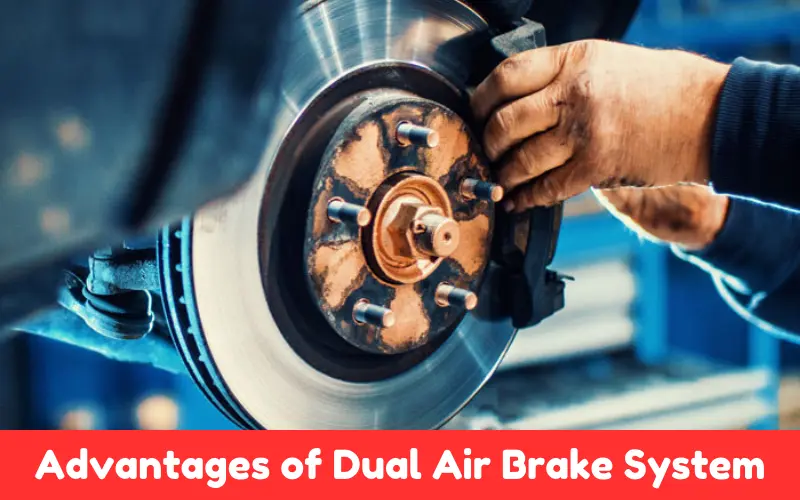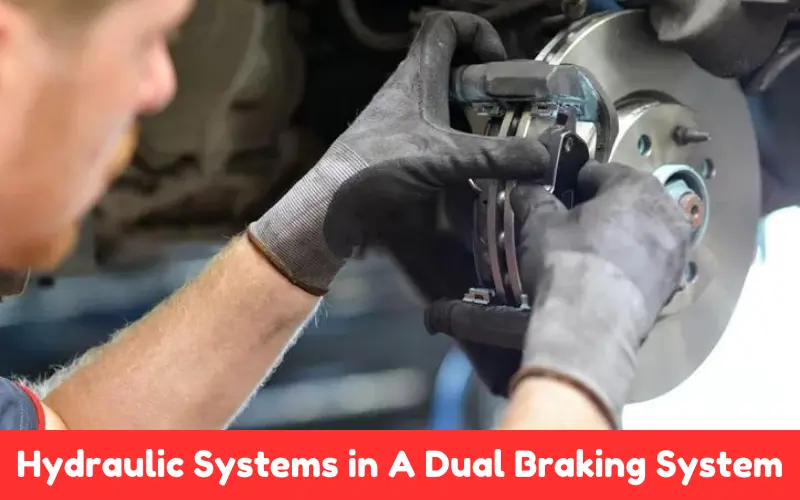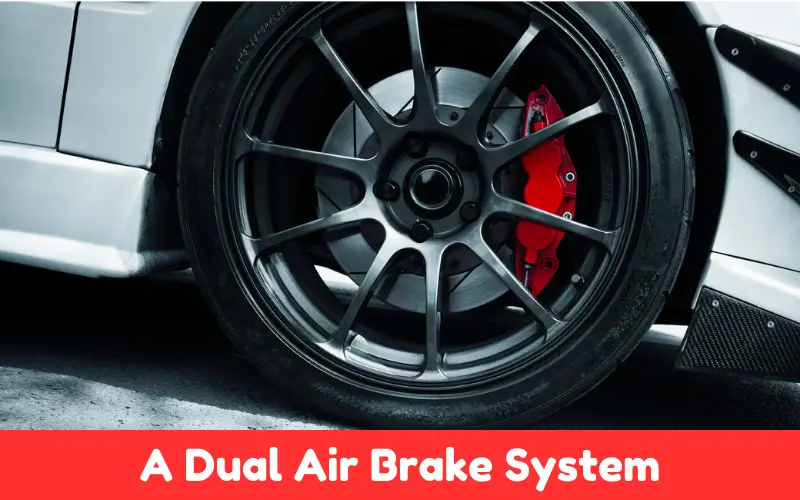Dual air brake system consist of two independent air circuits (primary and secondary). They are the standard for vehicle safety in heavy duty commercial vehicle’s, including commercial cars, trucks, buses, and numerous other applications.
Dual air brake systems are a great example of a technology that is required for the safety of vehicles that are transporting people and goods.
In this article we will discuss on what is a dual air brake system and its advantages.
Article Summary
What is A Dual Air Brake System
A dual air brake system is a safety feature used in most large vehicles, such as commercial trucks and buses.
This electric brake system ensures that braking works reliably and safely, as it is designed with two separate air brake circuits, the primary and secondary.
Primary Circuit
The primary circuit has the brake pedal, brake chambers, and brake drums/discs. When the driver presses the brake pedal, by the command, compressed air from the vehicle’s air compressor is sent through the primary circuit to actuate the brakes.
Secondary Circuit
The secondary circuit is a backup for the primary system. It features a separate set of brake chambers and actuators controlled by compressed air.
Still, much like the backup parachutes in the Stealth Fighter, it operates on a different air reservoir and ‘dumps’ automatically if there is a failure or large pressure drop in the primary circuit.
The secondary brake system circuit effectively doubles the hydraulic pressure in the primary to help bring the vehicle to a speed appropriate stop should the primary somehow fail.
Advantages of Dual Air Brake System
The main purpose of a dual air brake system is to increase the safety of a passenger aircraft by providing redundancy to the brake system.

The main advantages of a dual brake system are:
Redundancy
If one of the braking circuits leaks or fails, the other circuit is still good, so the driver can slow down and bring the car to a stop.
Higher Reliability
Dual systems are less likely to fail than single systems, meaning that if the vehicle needs to be reliable, it’s worth having a second try.
Legal Requirement
In many jurisdictions, dual air brake systems are a mandatory requirement for commercial vehicles exceeding a certain weight or passenger capacity. Print
Numbers of Reservoirs in A Dual Air Brake System
The design of the dual air brake system typically includes two separate air reservoirs (air reservoirs are storage containers where compressed air is stored to be used in the future by the vehicle’s brake system).
One is a primary reservoir (this reservoir gives air to the primary circuit, which includes the brake pedals, brake chambers, and actuators that are used to actuate the primary braking system when the driver applies pressure to the brake pedal).
Second is a secondary reservoir (this reservoir gives air to the secondary circuit, which acts as a backup circuit, so both reservoirs make the dual air brake system safe and reliable).
Each circuit can operate independently, so if the primary circuit leaks or malfunctions, all the components of the primary circuit can be replaced, leaving the secondary circuit and its reservoir intact and providing the necessary brake pressure to stop the vehicle safely.
Not only does a dual brake system satisfy regulatory requirements, but it also provides heavy duty commercial vehicles and buses with a redundant braking system that can operate effectively in various environmental conditions.
How Many Hydraulic Systems Are Used in A Dual Braking System?
Picture a dual braking system consisting of two circuits where the pressure generated inside each circuit is hydraulically independent of the other circuit.
This type of dual hydraulic circuit is common in many modern cars. In a dual braking system, if we lose the use of one side of the brakes (perhaps someone stole the brake pedal and won’t let go), the other side still functions.

All of these systems consist of a primary or passenger side hydraulic circuit incorporating the brake pedal and master cylinder that pressurizes hydraulic fluid to apply the brakes, in parallel with a secondary or driver side hydraulic circuit incorporating its own master cylinder, and a second set of brakes.
With such a system, if a leak or other failure occurs in one hydraulic circuit, the other circuit remains unimpaired; the vehicle can remain under control and brought to a stop.
This dual braking system design helps meet the highest safety standards while providing consistently reliable braking.
It reflects the reasons behind the notion of redundancy in automobile design, reassuring drivers that their brakes would work appropriately under various conditions, such as extreme temperatures and emergencies.
Inspect the Presence of Dual Air Brake System
There are a few pointers to help you but to be sure; you should check the vehicle’s specifications. You can check online using the make, model, and year of the vehicle, or you can check its vehicle information manual.
Usually, this type of information can be found on the vehicle information tags, which contain details about the type of braking system fitted on your car.
A visual inspection of the vehicle can also indicate this system: two separate air reservoirs, located on the chassis or near the wheels, should be labeled primary and secondary and attached separately to each respective hydraulic circuit.
Further, many commercial vehicles, such as heavy trucks and buses, are mandated to have dual air brake systems if their weight or passenger capacity is above certain cut offs. And ensuring compliance with local regulations tends to confirm a dual air brake situation.
Finally, owners can always refer to their vehicle’s loading weight. If in doubt, a professional mechanic or technician familiar with the systems used on heavy vehicles can provide accurate information and help you interpret the various brake configurations.
FAQs On What is A Dual Air Brake System
What is A Dual Air Brake System?
A dual air brake system is a braking system commonly used on large vehicles such as trucks and buses. It consists of two separate air braking systems, the primary circuit, and the secondary circuit, making it redundant. If one system fails, the other should be able to bring the vehicle to a safe stop.
How Does A Dual Air Brake System Work?
Primary circuit pressing the brake pedal sends the compressed air to the brake chamber to apply the brakes.
Secondary circuit is a separate circuit from the primary circuit. If there’s a failure in the primary circuit, the secondary circuit will automatically activate, preventing complete brake failure.
Why Are Dual Air Brake Systems Important?
Security needs to have a dual air brake system. This is because, in case of failure of the primary system, there is a stand by that reduces the risk of accidents and injuries when the brakes fail. This brake system improves the reliability of the vehicle and hence complies with the safety regulations.
Are A Dual Air Brake System Required By Law?
In many jurisdictions, there are laws requiring a dual air brake system on commercial vehicles that weigh more than a certain amount or carry more than a certain number of passengers. These laws are meant to improve the safety of vehicles on the road by requiring redundancy in systems that shutter vehicles and can bring them to a stop.
How Should A Dual Air Brake System Be Maintained?
A dual air brake system must be maintained regularly for optimal performance. This consists of checking for leaks, ensuring proper air pressure, periodic checks on brake parts for wear, and periodic testing to determine if the system is still intact and functioning well. This prevents failures and enables the brake system to operate properly.
Conclusion
Availability is improved by providing redundancy (as in dual air brake systems to boost the reliability of braking on large vehicles).
These systems use two independent circuits to provide redundancy and reassurance to drivers, operators, and passengers that braking will be available even if one component fails. Safety engineering is a significant contributor to reducing road accidents.

